Leadership Analysis: Servant Leadership in Healthcare Settings
VerifiedAdded on 2020/07/22
|11
|3471
|115
Report
AI Summary
This report provides an in-depth analysis of leadership approaches within healthcare, specifically focusing on the servant leadership model. It begins by presenting a real-world example of leadership within a clinic setting and then delves into the key characteristics of servant leadership, such as listening, empathy, healing, and foresight. The report describes how these characteristics are reflected in the example and explores the roles of healthcare professionals, patients, and carers within this approach. It also examines the contribution of servant leadership in fostering trust, autonomy, and effective decision-making. Furthermore, the report highlights opportunities for graduate nurses to develop leadership skills and concludes with a discussion on the essential factors for transitioning into a new role, including the role of paediatric nursing. The report emphasizes the importance of leadership in enhancing healthcare services and improving patient outcomes.
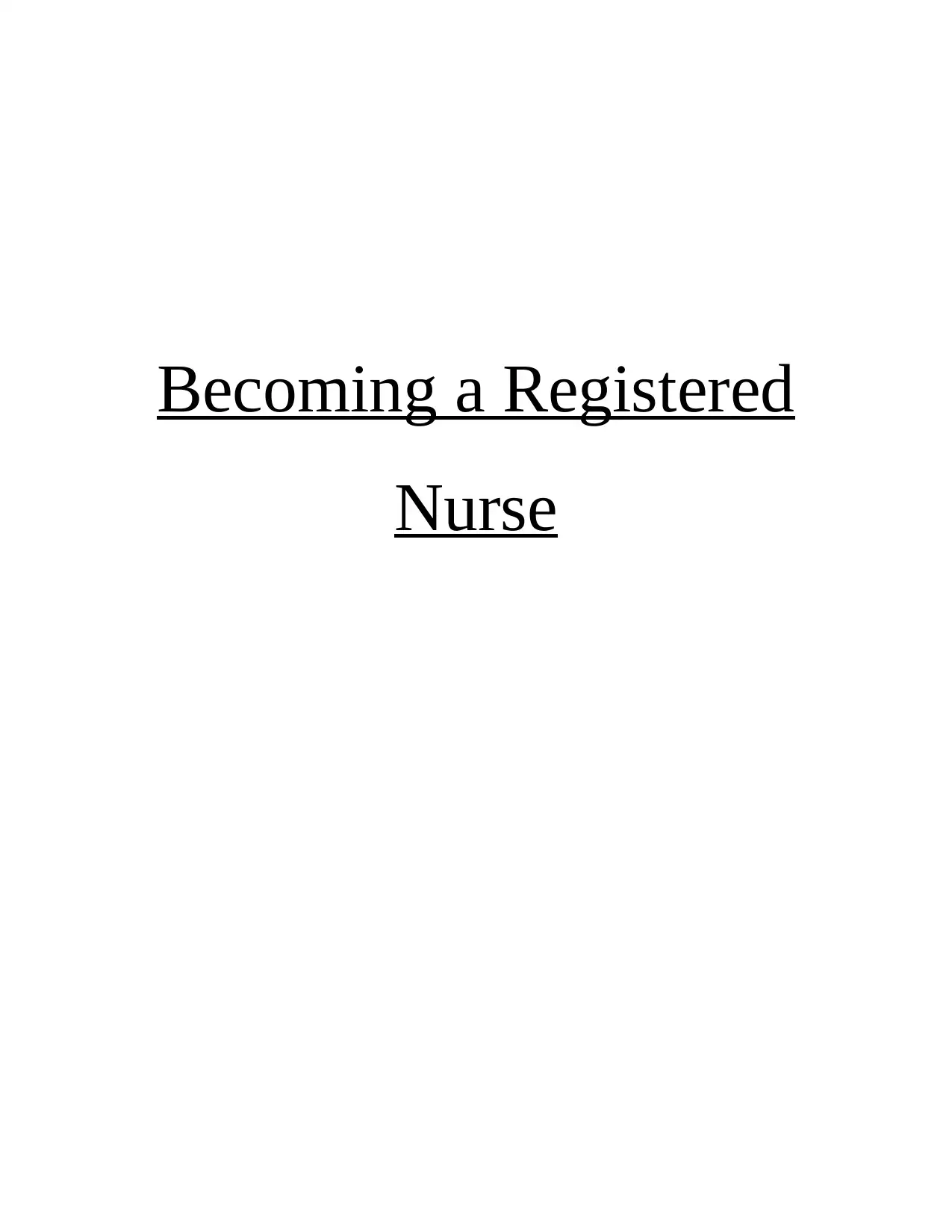
Becoming a Registered
Nurse
Nurse
Paraphrase This Document
Need a fresh take? Get an instant paraphrase of this document with our AI Paraphraser
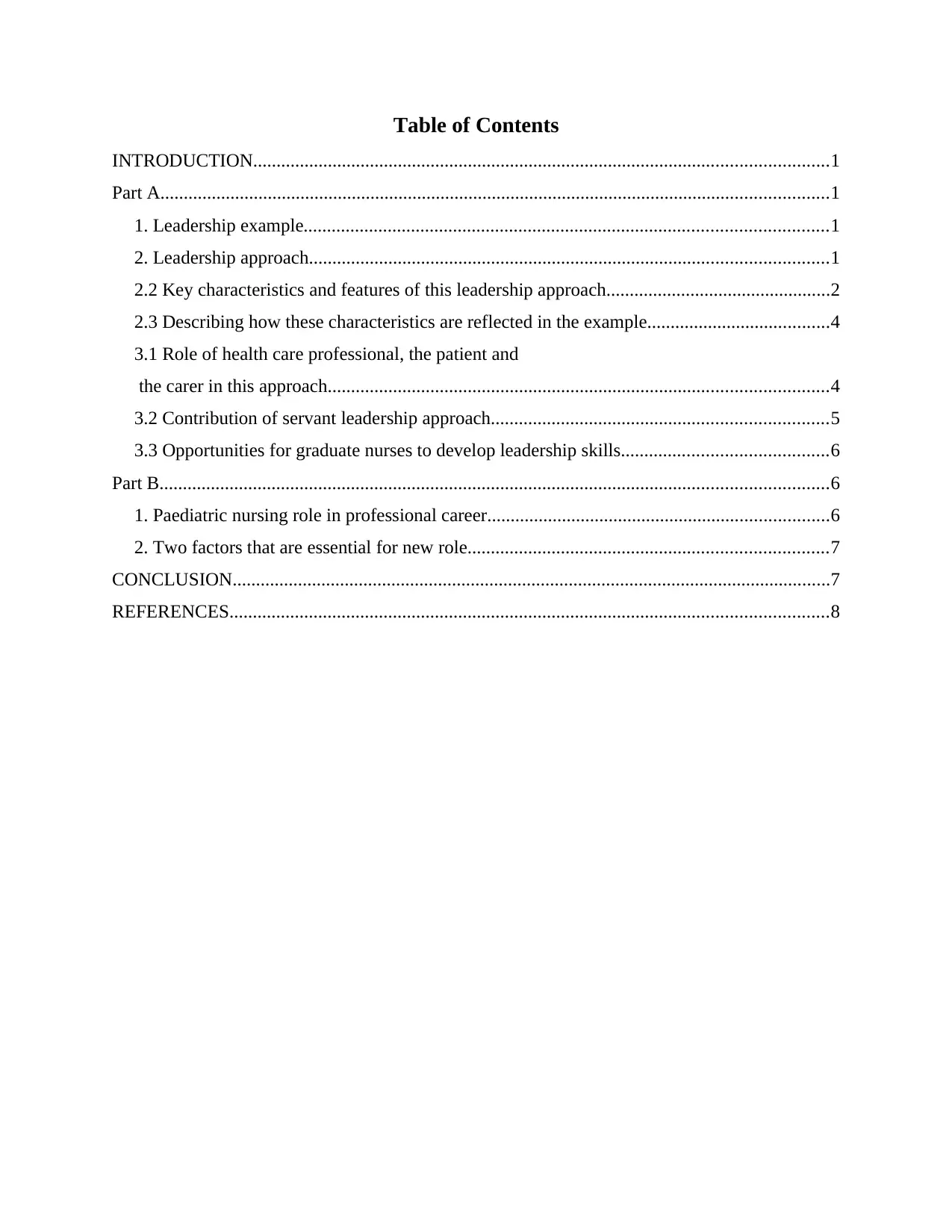
Table of Contents
INTRODUCTION...........................................................................................................................1
Part A...............................................................................................................................................1
1. Leadership example................................................................................................................1
2. Leadership approach...............................................................................................................1
2.2 Key characteristics and features of this leadership approach................................................2
2.3 Describing how these characteristics are reflected in the example.......................................4
3.1 Role of health care professional, the patient and
the carer in this approach...........................................................................................................4
3.2 Contribution of servant leadership approach........................................................................5
3.3 Opportunities for graduate nurses to develop leadership skills............................................6
Part B...............................................................................................................................................6
1. Paediatric nursing role in professional career.........................................................................6
2. Two factors that are essential for new role.............................................................................7
CONCLUSION................................................................................................................................7
REFERENCES................................................................................................................................8
INTRODUCTION...........................................................................................................................1
Part A...............................................................................................................................................1
1. Leadership example................................................................................................................1
2. Leadership approach...............................................................................................................1
2.2 Key characteristics and features of this leadership approach................................................2
2.3 Describing how these characteristics are reflected in the example.......................................4
3.1 Role of health care professional, the patient and
the carer in this approach...........................................................................................................4
3.2 Contribution of servant leadership approach........................................................................5
3.3 Opportunities for graduate nurses to develop leadership skills............................................6
Part B...............................................................................................................................................6
1. Paediatric nursing role in professional career.........................................................................6
2. Two factors that are essential for new role.............................................................................7
CONCLUSION................................................................................................................................7
REFERENCES................................................................................................................................8
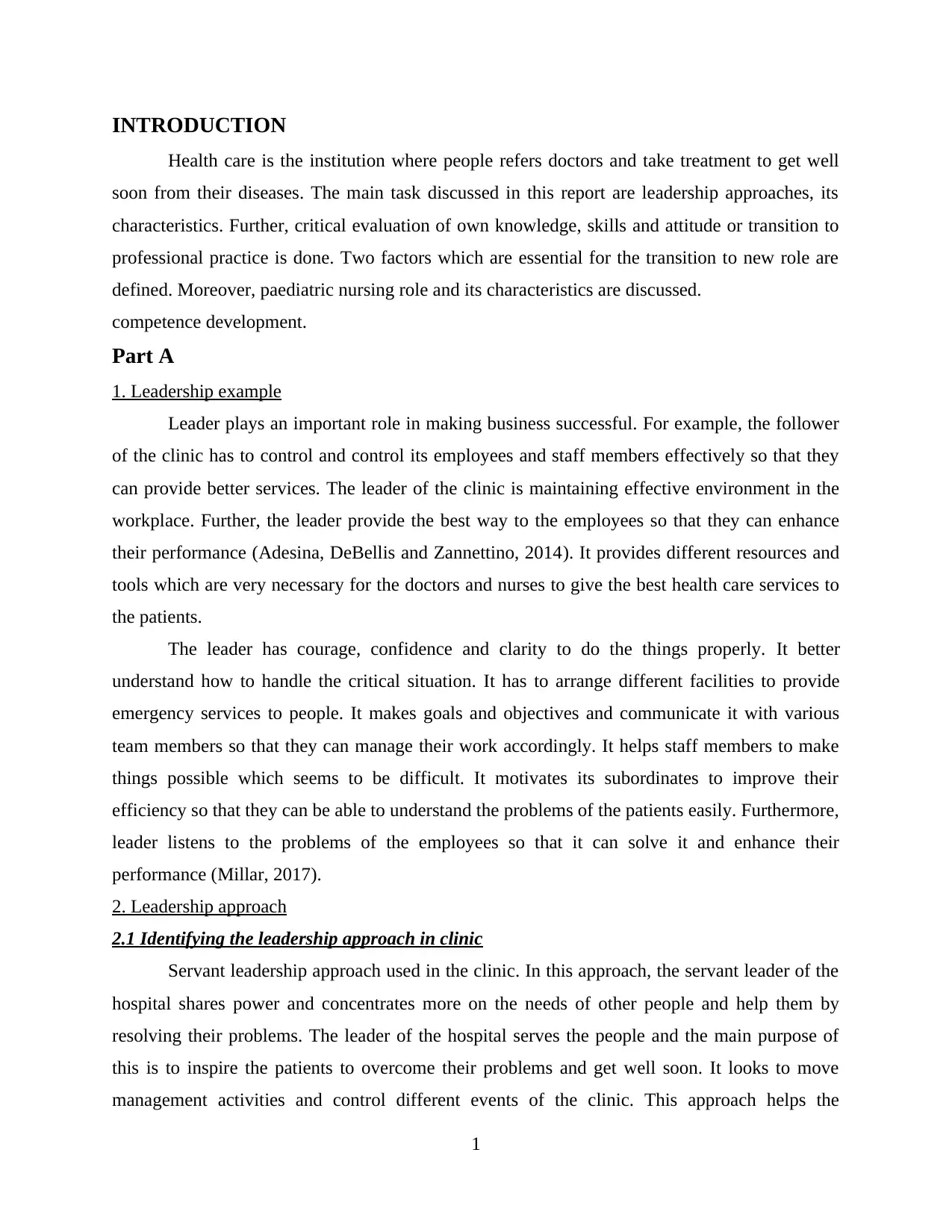
INTRODUCTION
Health care is the institution where people refers doctors and take treatment to get well
soon from their diseases. The main task discussed in this report are leadership approaches, its
characteristics. Further, critical evaluation of own knowledge, skills and attitude or transition to
professional practice is done. Two factors which are essential for the transition to new role are
defined. Moreover, paediatric nursing role and its characteristics are discussed.
competence development.
Part A
1. Leadership example
Leader plays an important role in making business successful. For example, the follower
of the clinic has to control and control its employees and staff members effectively so that they
can provide better services. The leader of the clinic is maintaining effective environment in the
workplace. Further, the leader provide the best way to the employees so that they can enhance
their performance (Adesina, DeBellis and Zannettino, 2014). It provides different resources and
tools which are very necessary for the doctors and nurses to give the best health care services to
the patients.
The leader has courage, confidence and clarity to do the things properly. It better
understand how to handle the critical situation. It has to arrange different facilities to provide
emergency services to people. It makes goals and objectives and communicate it with various
team members so that they can manage their work accordingly. It helps staff members to make
things possible which seems to be difficult. It motivates its subordinates to improve their
efficiency so that they can be able to understand the problems of the patients easily. Furthermore,
leader listens to the problems of the employees so that it can solve it and enhance their
performance (Millar, 2017).
2. Leadership approach
2.1 Identifying the leadership approach in clinic
Servant leadership approach used in the clinic. In this approach, the servant leader of the
hospital shares power and concentrates more on the needs of other people and help them by
resolving their problems. The leader of the hospital serves the people and the main purpose of
this is to inspire the patients to overcome their problems and get well soon. It looks to move
management activities and control different events of the clinic. This approach helps the
1
Health care is the institution where people refers doctors and take treatment to get well
soon from their diseases. The main task discussed in this report are leadership approaches, its
characteristics. Further, critical evaluation of own knowledge, skills and attitude or transition to
professional practice is done. Two factors which are essential for the transition to new role are
defined. Moreover, paediatric nursing role and its characteristics are discussed.
competence development.
Part A
1. Leadership example
Leader plays an important role in making business successful. For example, the follower
of the clinic has to control and control its employees and staff members effectively so that they
can provide better services. The leader of the clinic is maintaining effective environment in the
workplace. Further, the leader provide the best way to the employees so that they can enhance
their performance (Adesina, DeBellis and Zannettino, 2014). It provides different resources and
tools which are very necessary for the doctors and nurses to give the best health care services to
the patients.
The leader has courage, confidence and clarity to do the things properly. It better
understand how to handle the critical situation. It has to arrange different facilities to provide
emergency services to people. It makes goals and objectives and communicate it with various
team members so that they can manage their work accordingly. It helps staff members to make
things possible which seems to be difficult. It motivates its subordinates to improve their
efficiency so that they can be able to understand the problems of the patients easily. Furthermore,
leader listens to the problems of the employees so that it can solve it and enhance their
performance (Millar, 2017).
2. Leadership approach
2.1 Identifying the leadership approach in clinic
Servant leadership approach used in the clinic. In this approach, the servant leader of the
hospital shares power and concentrates more on the needs of other people and help them by
resolving their problems. The leader of the hospital serves the people and the main purpose of
this is to inspire the patients to overcome their problems and get well soon. It looks to move
management activities and control different events of the clinic. This approach helps the
1
⊘ This is a preview!⊘
Do you want full access?
Subscribe today to unlock all pages.

Trusted by 1+ million students worldwide
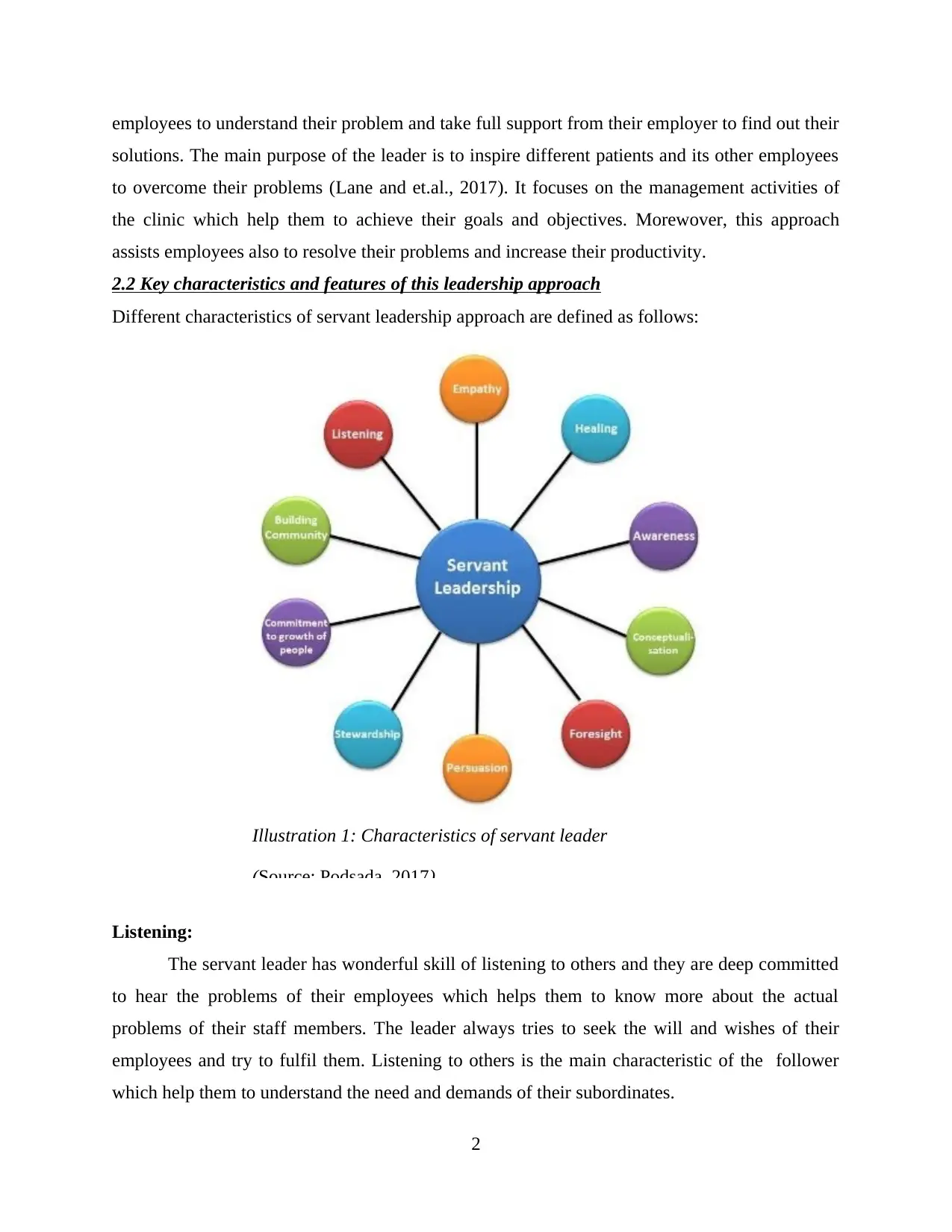
employees to understand their problem and take full support from their employer to find out their
solutions. The main purpose of the leader is to inspire different patients and its other employees
to overcome their problems (Lane and et.al., 2017). It focuses on the management activities of
the clinic which help them to achieve their goals and objectives. Morewover, this approach
assists employees also to resolve their problems and increase their productivity.
2.2 Key characteristics and features of this leadership approach
Different characteristics of servant leadership approach are defined as follows:
Listening:
The servant leader has wonderful skill of listening to others and they are deep committed
to hear the problems of their employees which helps them to know more about the actual
problems of their staff members. The leader always tries to seek the will and wishes of their
employees and try to fulfil them. Listening to others is the main characteristic of the follower
which help them to understand the need and demands of their subordinates.
2
Illustration 1: Characteristics of servant leader
(Source: Podsada, 2017)
solutions. The main purpose of the leader is to inspire different patients and its other employees
to overcome their problems (Lane and et.al., 2017). It focuses on the management activities of
the clinic which help them to achieve their goals and objectives. Morewover, this approach
assists employees also to resolve their problems and increase their productivity.
2.2 Key characteristics and features of this leadership approach
Different characteristics of servant leadership approach are defined as follows:
Listening:
The servant leader has wonderful skill of listening to others and they are deep committed
to hear the problems of their employees which helps them to know more about the actual
problems of their staff members. The leader always tries to seek the will and wishes of their
employees and try to fulfil them. Listening to others is the main characteristic of the follower
which help them to understand the need and demands of their subordinates.
2
Illustration 1: Characteristics of servant leader
(Source: Podsada, 2017)
Paraphrase This Document
Need a fresh take? Get an instant paraphrase of this document with our AI Paraphraser
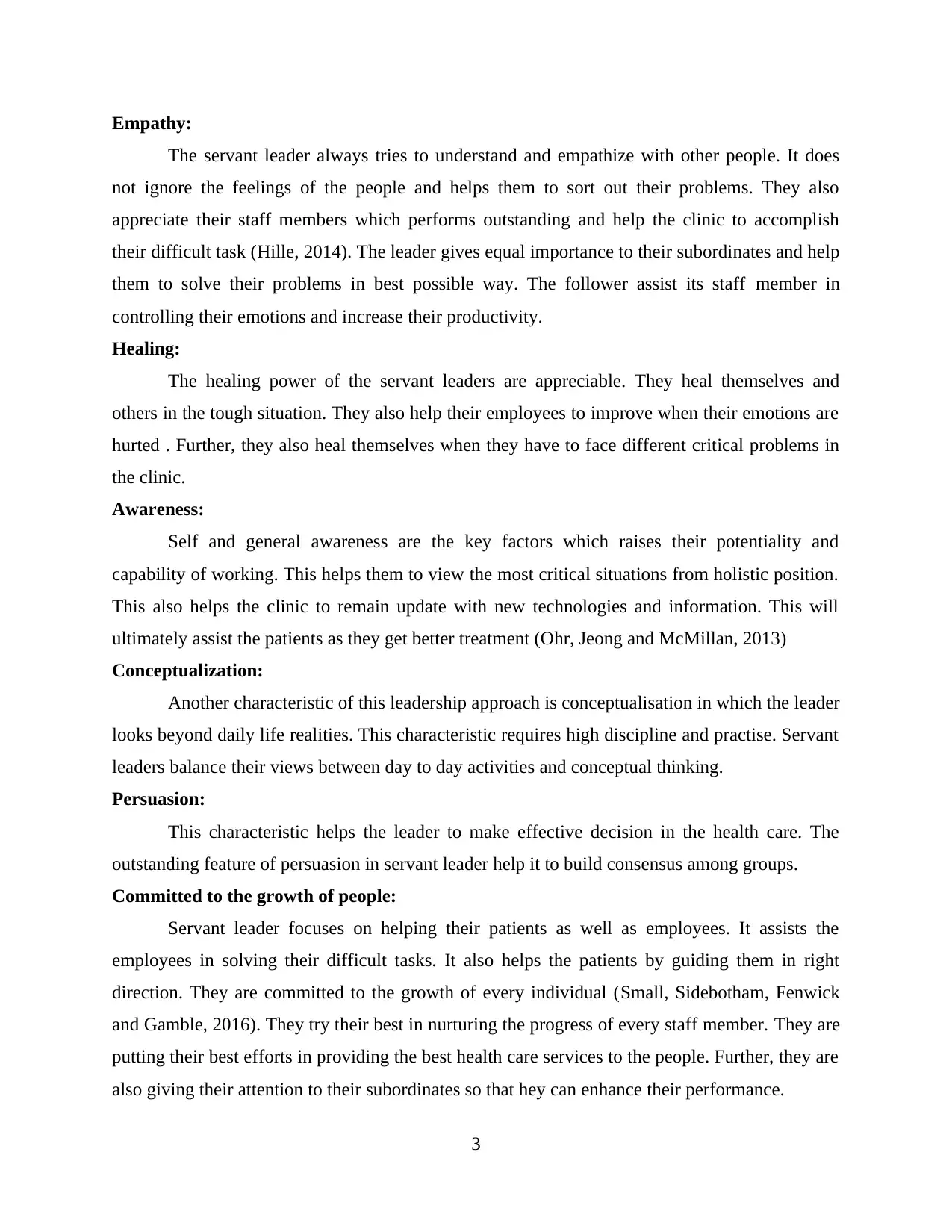
Empathy:
The servant leader always tries to understand and empathize with other people. It does
not ignore the feelings of the people and helps them to sort out their problems. They also
appreciate their staff members which performs outstanding and help the clinic to accomplish
their difficult task (Hille, 2014). The leader gives equal importance to their subordinates and help
them to solve their problems in best possible way. The follower assist its staff member in
controlling their emotions and increase their productivity.
Healing:
The healing power of the servant leaders are appreciable. They heal themselves and
others in the tough situation. They also help their employees to improve when their emotions are
hurted . Further, they also heal themselves when they have to face different critical problems in
the clinic.
Awareness:
Self and general awareness are the key factors which raises their potentiality and
capability of working. This helps them to view the most critical situations from holistic position.
This also helps the clinic to remain update with new technologies and information. This will
ultimately assist the patients as they get better treatment (Ohr, Jeong and McMillan, 2013)
Conceptualization:
Another characteristic of this leadership approach is conceptualisation in which the leader
looks beyond daily life realities. This characteristic requires high discipline and practise. Servant
leaders balance their views between day to day activities and conceptual thinking.
Persuasion:
This characteristic helps the leader to make effective decision in the health care. The
outstanding feature of persuasion in servant leader help it to build consensus among groups.
Committed to the growth of people:
Servant leader focuses on helping their patients as well as employees. It assists the
employees in solving their difficult tasks. It also helps the patients by guiding them in right
direction. They are committed to the growth of every individual (Small, Sidebotham, Fenwick
and Gamble, 2016). They try their best in nurturing the progress of every staff member. They are
putting their best efforts in providing the best health care services to the people. Further, they are
also giving their attention to their subordinates so that hey can enhance their performance.
3
The servant leader always tries to understand and empathize with other people. It does
not ignore the feelings of the people and helps them to sort out their problems. They also
appreciate their staff members which performs outstanding and help the clinic to accomplish
their difficult task (Hille, 2014). The leader gives equal importance to their subordinates and help
them to solve their problems in best possible way. The follower assist its staff member in
controlling their emotions and increase their productivity.
Healing:
The healing power of the servant leaders are appreciable. They heal themselves and
others in the tough situation. They also help their employees to improve when their emotions are
hurted . Further, they also heal themselves when they have to face different critical problems in
the clinic.
Awareness:
Self and general awareness are the key factors which raises their potentiality and
capability of working. This helps them to view the most critical situations from holistic position.
This also helps the clinic to remain update with new technologies and information. This will
ultimately assist the patients as they get better treatment (Ohr, Jeong and McMillan, 2013)
Conceptualization:
Another characteristic of this leadership approach is conceptualisation in which the leader
looks beyond daily life realities. This characteristic requires high discipline and practise. Servant
leaders balance their views between day to day activities and conceptual thinking.
Persuasion:
This characteristic helps the leader to make effective decision in the health care. The
outstanding feature of persuasion in servant leader help it to build consensus among groups.
Committed to the growth of people:
Servant leader focuses on helping their patients as well as employees. It assists the
employees in solving their difficult tasks. It also helps the patients by guiding them in right
direction. They are committed to the growth of every individual (Small, Sidebotham, Fenwick
and Gamble, 2016). They try their best in nurturing the progress of every staff member. They are
putting their best efforts in providing the best health care services to the people. Further, they are
also giving their attention to their subordinates so that hey can enhance their performance.
3
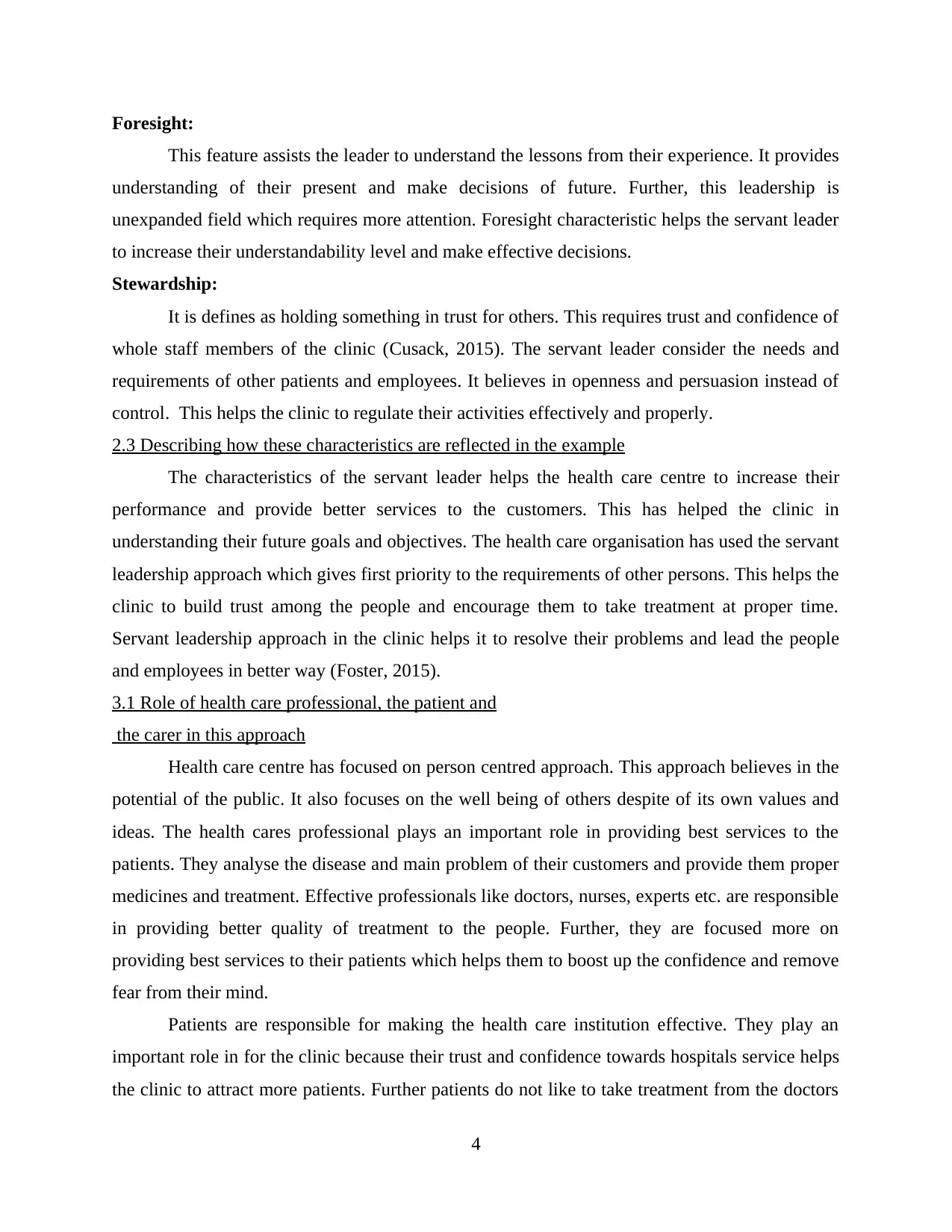
Foresight:
This feature assists the leader to understand the lessons from their experience. It provides
understanding of their present and make decisions of future. Further, this leadership is
unexpanded field which requires more attention. Foresight characteristic helps the servant leader
to increase their understandability level and make effective decisions.
Stewardship:
It is defines as holding something in trust for others. This requires trust and confidence of
whole staff members of the clinic (Cusack, 2015). The servant leader consider the needs and
requirements of other patients and employees. It believes in openness and persuasion instead of
control. This helps the clinic to regulate their activities effectively and properly.
2.3 Describing how these characteristics are reflected in the example
The characteristics of the servant leader helps the health care centre to increase their
performance and provide better services to the customers. This has helped the clinic in
understanding their future goals and objectives. The health care organisation has used the servant
leadership approach which gives first priority to the requirements of other persons. This helps the
clinic to build trust among the people and encourage them to take treatment at proper time.
Servant leadership approach in the clinic helps it to resolve their problems and lead the people
and employees in better way (Foster, 2015).
3.1 Role of health care professional, the patient and
the carer in this approach
Health care centre has focused on person centred approach. This approach believes in the
potential of the public. It also focuses on the well being of others despite of its own values and
ideas. The health cares professional plays an important role in providing best services to the
patients. They analyse the disease and main problem of their customers and provide them proper
medicines and treatment. Effective professionals like doctors, nurses, experts etc. are responsible
in providing better quality of treatment to the people. Further, they are focused more on
providing best services to their patients which helps them to boost up the confidence and remove
fear from their mind.
Patients are responsible for making the health care institution effective. They play an
important role in for the clinic because their trust and confidence towards hospitals service helps
the clinic to attract more patients. Further patients do not like to take treatment from the doctors
4
This feature assists the leader to understand the lessons from their experience. It provides
understanding of their present and make decisions of future. Further, this leadership is
unexpanded field which requires more attention. Foresight characteristic helps the servant leader
to increase their understandability level and make effective decisions.
Stewardship:
It is defines as holding something in trust for others. This requires trust and confidence of
whole staff members of the clinic (Cusack, 2015). The servant leader consider the needs and
requirements of other patients and employees. It believes in openness and persuasion instead of
control. This helps the clinic to regulate their activities effectively and properly.
2.3 Describing how these characteristics are reflected in the example
The characteristics of the servant leader helps the health care centre to increase their
performance and provide better services to the customers. This has helped the clinic in
understanding their future goals and objectives. The health care organisation has used the servant
leadership approach which gives first priority to the requirements of other persons. This helps the
clinic to build trust among the people and encourage them to take treatment at proper time.
Servant leadership approach in the clinic helps it to resolve their problems and lead the people
and employees in better way (Foster, 2015).
3.1 Role of health care professional, the patient and
the carer in this approach
Health care centre has focused on person centred approach. This approach believes in the
potential of the public. It also focuses on the well being of others despite of its own values and
ideas. The health cares professional plays an important role in providing best services to the
patients. They analyse the disease and main problem of their customers and provide them proper
medicines and treatment. Effective professionals like doctors, nurses, experts etc. are responsible
in providing better quality of treatment to the people. Further, they are focused more on
providing best services to their patients which helps them to boost up the confidence and remove
fear from their mind.
Patients are responsible for making the health care institution effective. They play an
important role in for the clinic because their trust and confidence towards hospitals service helps
the clinic to attract more patients. Further patients do not like to take treatment from the doctors
4
⊘ This is a preview!⊘
Do you want full access?
Subscribe today to unlock all pages.

Trusted by 1+ million students worldwide
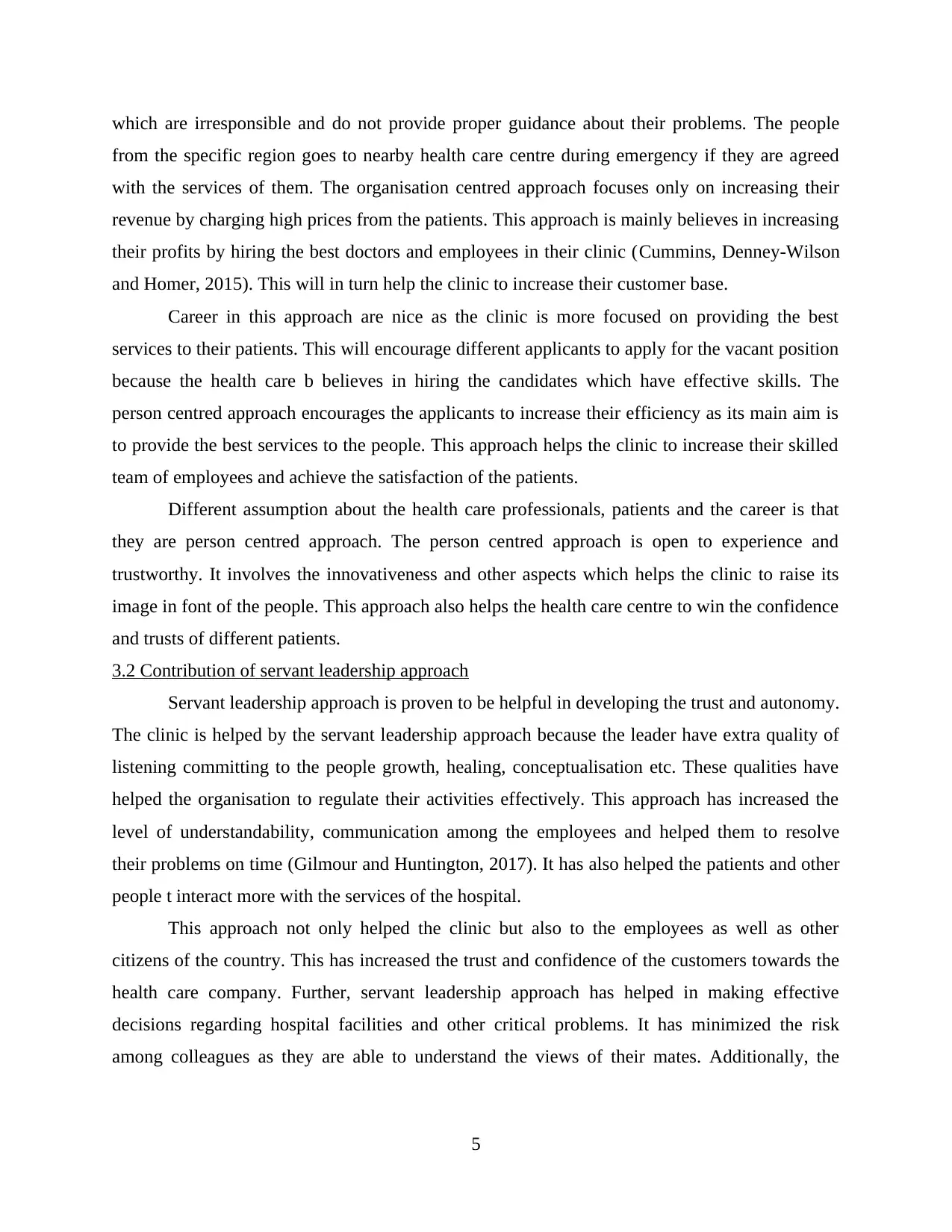
which are irresponsible and do not provide proper guidance about their problems. The people
from the specific region goes to nearby health care centre during emergency if they are agreed
with the services of them. The organisation centred approach focuses only on increasing their
revenue by charging high prices from the patients. This approach is mainly believes in increasing
their profits by hiring the best doctors and employees in their clinic (Cummins, Denney-Wilson
and Homer, 2015). This will in turn help the clinic to increase their customer base.
Career in this approach are nice as the clinic is more focused on providing the best
services to their patients. This will encourage different applicants to apply for the vacant position
because the health care b believes in hiring the candidates which have effective skills. The
person centred approach encourages the applicants to increase their efficiency as its main aim is
to provide the best services to the people. This approach helps the clinic to increase their skilled
team of employees and achieve the satisfaction of the patients.
Different assumption about the health care professionals, patients and the career is that
they are person centred approach. The person centred approach is open to experience and
trustworthy. It involves the innovativeness and other aspects which helps the clinic to raise its
image in font of the people. This approach also helps the health care centre to win the confidence
and trusts of different patients.
3.2 Contribution of servant leadership approach
Servant leadership approach is proven to be helpful in developing the trust and autonomy.
The clinic is helped by the servant leadership approach because the leader have extra quality of
listening committing to the people growth, healing, conceptualisation etc. These qualities have
helped the organisation to regulate their activities effectively. This approach has increased the
level of understandability, communication among the employees and helped them to resolve
their problems on time (Gilmour and Huntington, 2017). It has also helped the patients and other
people t interact more with the services of the hospital.
This approach not only helped the clinic but also to the employees as well as other
citizens of the country. This has increased the trust and confidence of the customers towards the
health care company. Further, servant leadership approach has helped in making effective
decisions regarding hospital facilities and other critical problems. It has minimized the risk
among colleagues as they are able to understand the views of their mates. Additionally, the
5
from the specific region goes to nearby health care centre during emergency if they are agreed
with the services of them. The organisation centred approach focuses only on increasing their
revenue by charging high prices from the patients. This approach is mainly believes in increasing
their profits by hiring the best doctors and employees in their clinic (Cummins, Denney-Wilson
and Homer, 2015). This will in turn help the clinic to increase their customer base.
Career in this approach are nice as the clinic is more focused on providing the best
services to their patients. This will encourage different applicants to apply for the vacant position
because the health care b believes in hiring the candidates which have effective skills. The
person centred approach encourages the applicants to increase their efficiency as its main aim is
to provide the best services to the people. This approach helps the clinic to increase their skilled
team of employees and achieve the satisfaction of the patients.
Different assumption about the health care professionals, patients and the career is that
they are person centred approach. The person centred approach is open to experience and
trustworthy. It involves the innovativeness and other aspects which helps the clinic to raise its
image in font of the people. This approach also helps the health care centre to win the confidence
and trusts of different patients.
3.2 Contribution of servant leadership approach
Servant leadership approach is proven to be helpful in developing the trust and autonomy.
The clinic is helped by the servant leadership approach because the leader have extra quality of
listening committing to the people growth, healing, conceptualisation etc. These qualities have
helped the organisation to regulate their activities effectively. This approach has increased the
level of understandability, communication among the employees and helped them to resolve
their problems on time (Gilmour and Huntington, 2017). It has also helped the patients and other
people t interact more with the services of the hospital.
This approach not only helped the clinic but also to the employees as well as other
citizens of the country. This has increased the trust and confidence of the customers towards the
health care company. Further, servant leadership approach has helped in making effective
decisions regarding hospital facilities and other critical problems. It has minimized the risk
among colleagues as they are able to understand the views of their mates. Additionally, the
5
Paraphrase This Document
Need a fresh take? Get an instant paraphrase of this document with our AI Paraphraser
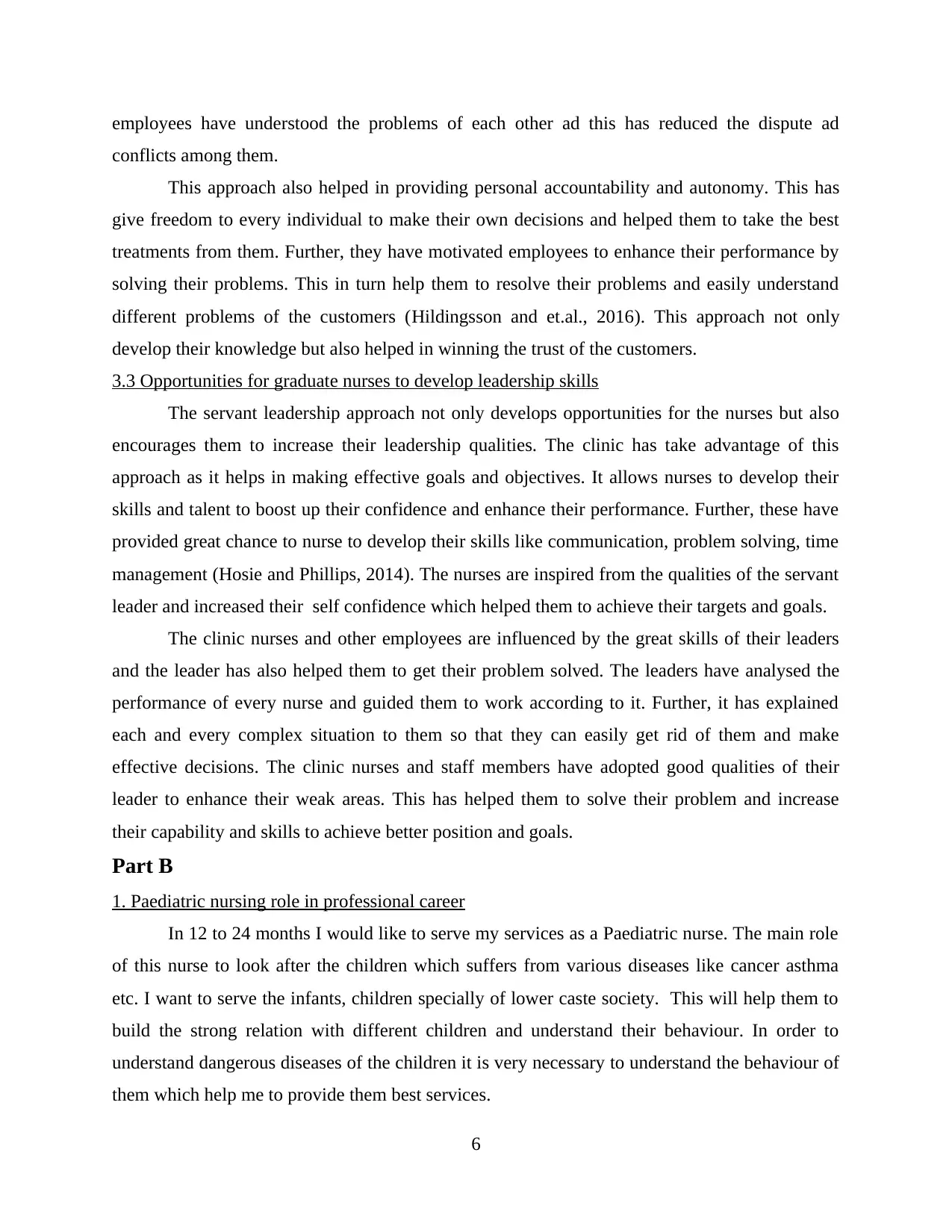
employees have understood the problems of each other ad this has reduced the dispute ad
conflicts among them.
This approach also helped in providing personal accountability and autonomy. This has
give freedom to every individual to make their own decisions and helped them to take the best
treatments from them. Further, they have motivated employees to enhance their performance by
solving their problems. This in turn help them to resolve their problems and easily understand
different problems of the customers (Hildingsson and et.al., 2016). This approach not only
develop their knowledge but also helped in winning the trust of the customers.
3.3 Opportunities for graduate nurses to develop leadership skills
The servant leadership approach not only develops opportunities for the nurses but also
encourages them to increase their leadership qualities. The clinic has take advantage of this
approach as it helps in making effective goals and objectives. It allows nurses to develop their
skills and talent to boost up their confidence and enhance their performance. Further, these have
provided great chance to nurse to develop their skills like communication, problem solving, time
management (Hosie and Phillips, 2014). The nurses are inspired from the qualities of the servant
leader and increased their self confidence which helped them to achieve their targets and goals.
The clinic nurses and other employees are influenced by the great skills of their leaders
and the leader has also helped them to get their problem solved. The leaders have analysed the
performance of every nurse and guided them to work according to it. Further, it has explained
each and every complex situation to them so that they can easily get rid of them and make
effective decisions. The clinic nurses and staff members have adopted good qualities of their
leader to enhance their weak areas. This has helped them to solve their problem and increase
their capability and skills to achieve better position and goals.
Part B
1. Paediatric nursing role in professional career
In 12 to 24 months I would like to serve my services as a Paediatric nurse. The main role
of this nurse to look after the children which suffers from various diseases like cancer asthma
etc. I want to serve the infants, children specially of lower caste society. This will help them to
build the strong relation with different children and understand their behaviour. In order to
understand dangerous diseases of the children it is very necessary to understand the behaviour of
them which help me to provide them best services.
6
conflicts among them.
This approach also helped in providing personal accountability and autonomy. This has
give freedom to every individual to make their own decisions and helped them to take the best
treatments from them. Further, they have motivated employees to enhance their performance by
solving their problems. This in turn help them to resolve their problems and easily understand
different problems of the customers (Hildingsson and et.al., 2016). This approach not only
develop their knowledge but also helped in winning the trust of the customers.
3.3 Opportunities for graduate nurses to develop leadership skills
The servant leadership approach not only develops opportunities for the nurses but also
encourages them to increase their leadership qualities. The clinic has take advantage of this
approach as it helps in making effective goals and objectives. It allows nurses to develop their
skills and talent to boost up their confidence and enhance their performance. Further, these have
provided great chance to nurse to develop their skills like communication, problem solving, time
management (Hosie and Phillips, 2014). The nurses are inspired from the qualities of the servant
leader and increased their self confidence which helped them to achieve their targets and goals.
The clinic nurses and other employees are influenced by the great skills of their leaders
and the leader has also helped them to get their problem solved. The leaders have analysed the
performance of every nurse and guided them to work according to it. Further, it has explained
each and every complex situation to them so that they can easily get rid of them and make
effective decisions. The clinic nurses and staff members have adopted good qualities of their
leader to enhance their weak areas. This has helped them to solve their problem and increase
their capability and skills to achieve better position and goals.
Part B
1. Paediatric nursing role in professional career
In 12 to 24 months I would like to serve my services as a Paediatric nurse. The main role
of this nurse to look after the children which suffers from various diseases like cancer asthma
etc. I want to serve the infants, children specially of lower caste society. This will help them to
build the strong relation with different children and understand their behaviour. In order to
understand dangerous diseases of the children it is very necessary to understand the behaviour of
them which help me to provide them best services.
6
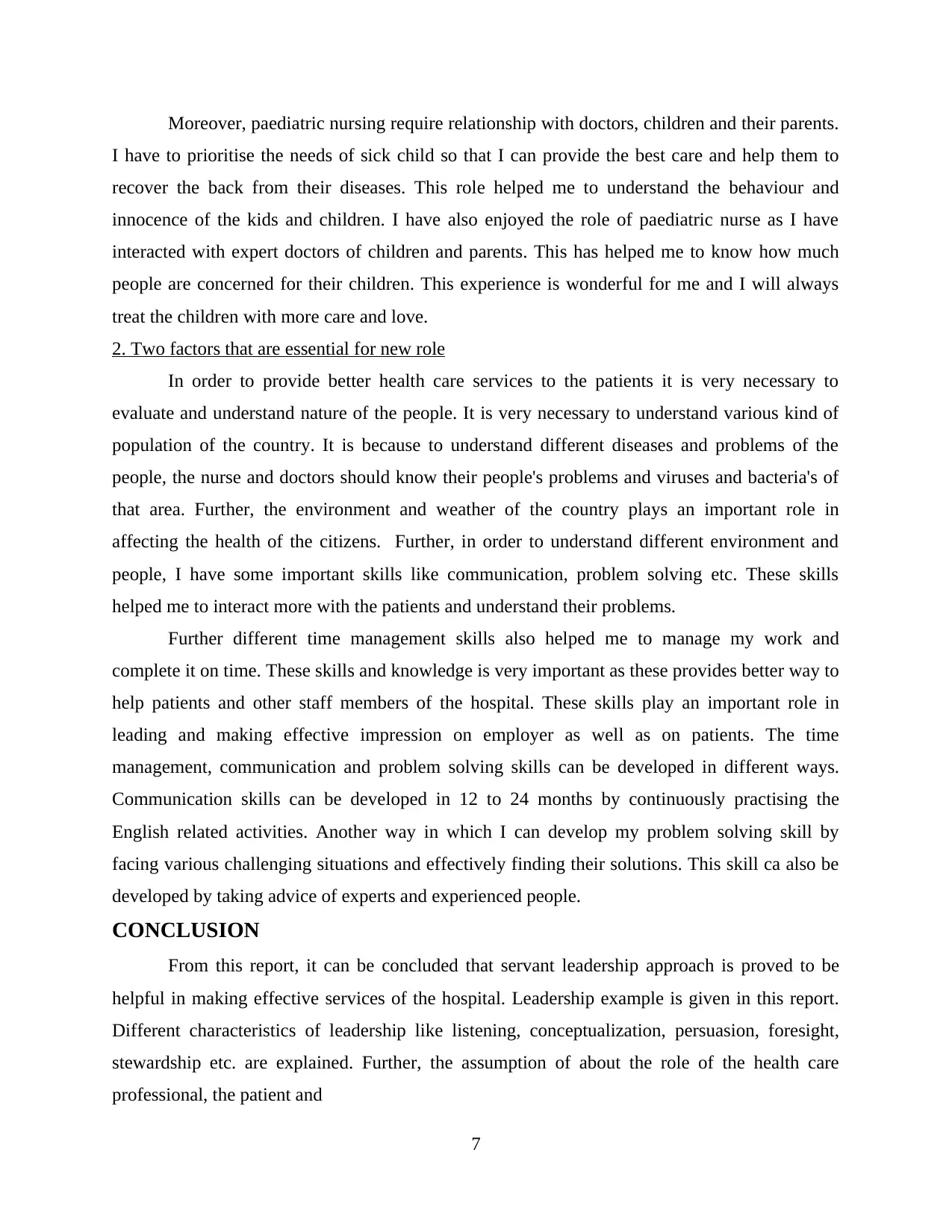
Moreover, paediatric nursing require relationship with doctors, children and their parents.
I have to prioritise the needs of sick child so that I can provide the best care and help them to
recover the back from their diseases. This role helped me to understand the behaviour and
innocence of the kids and children. I have also enjoyed the role of paediatric nurse as I have
interacted with expert doctors of children and parents. This has helped me to know how much
people are concerned for their children. This experience is wonderful for me and I will always
treat the children with more care and love.
2. Two factors that are essential for new role
In order to provide better health care services to the patients it is very necessary to
evaluate and understand nature of the people. It is very necessary to understand various kind of
population of the country. It is because to understand different diseases and problems of the
people, the nurse and doctors should know their people's problems and viruses and bacteria's of
that area. Further, the environment and weather of the country plays an important role in
affecting the health of the citizens. Further, in order to understand different environment and
people, I have some important skills like communication, problem solving etc. These skills
helped me to interact more with the patients and understand their problems.
Further different time management skills also helped me to manage my work and
complete it on time. These skills and knowledge is very important as these provides better way to
help patients and other staff members of the hospital. These skills play an important role in
leading and making effective impression on employer as well as on patients. The time
management, communication and problem solving skills can be developed in different ways.
Communication skills can be developed in 12 to 24 months by continuously practising the
English related activities. Another way in which I can develop my problem solving skill by
facing various challenging situations and effectively finding their solutions. This skill ca also be
developed by taking advice of experts and experienced people.
CONCLUSION
From this report, it can be concluded that servant leadership approach is proved to be
helpful in making effective services of the hospital. Leadership example is given in this report.
Different characteristics of leadership like listening, conceptualization, persuasion, foresight,
stewardship etc. are explained. Further, the assumption of about the role of the health care
professional, the patient and
7
I have to prioritise the needs of sick child so that I can provide the best care and help them to
recover the back from their diseases. This role helped me to understand the behaviour and
innocence of the kids and children. I have also enjoyed the role of paediatric nurse as I have
interacted with expert doctors of children and parents. This has helped me to know how much
people are concerned for their children. This experience is wonderful for me and I will always
treat the children with more care and love.
2. Two factors that are essential for new role
In order to provide better health care services to the patients it is very necessary to
evaluate and understand nature of the people. It is very necessary to understand various kind of
population of the country. It is because to understand different diseases and problems of the
people, the nurse and doctors should know their people's problems and viruses and bacteria's of
that area. Further, the environment and weather of the country plays an important role in
affecting the health of the citizens. Further, in order to understand different environment and
people, I have some important skills like communication, problem solving etc. These skills
helped me to interact more with the patients and understand their problems.
Further different time management skills also helped me to manage my work and
complete it on time. These skills and knowledge is very important as these provides better way to
help patients and other staff members of the hospital. These skills play an important role in
leading and making effective impression on employer as well as on patients. The time
management, communication and problem solving skills can be developed in different ways.
Communication skills can be developed in 12 to 24 months by continuously practising the
English related activities. Another way in which I can develop my problem solving skill by
facing various challenging situations and effectively finding their solutions. This skill ca also be
developed by taking advice of experts and experienced people.
CONCLUSION
From this report, it can be concluded that servant leadership approach is proved to be
helpful in making effective services of the hospital. Leadership example is given in this report.
Different characteristics of leadership like listening, conceptualization, persuasion, foresight,
stewardship etc. are explained. Further, the assumption of about the role of the health care
professional, the patient and
7
⊘ This is a preview!⊘
Do you want full access?
Subscribe today to unlock all pages.

Trusted by 1+ million students worldwide
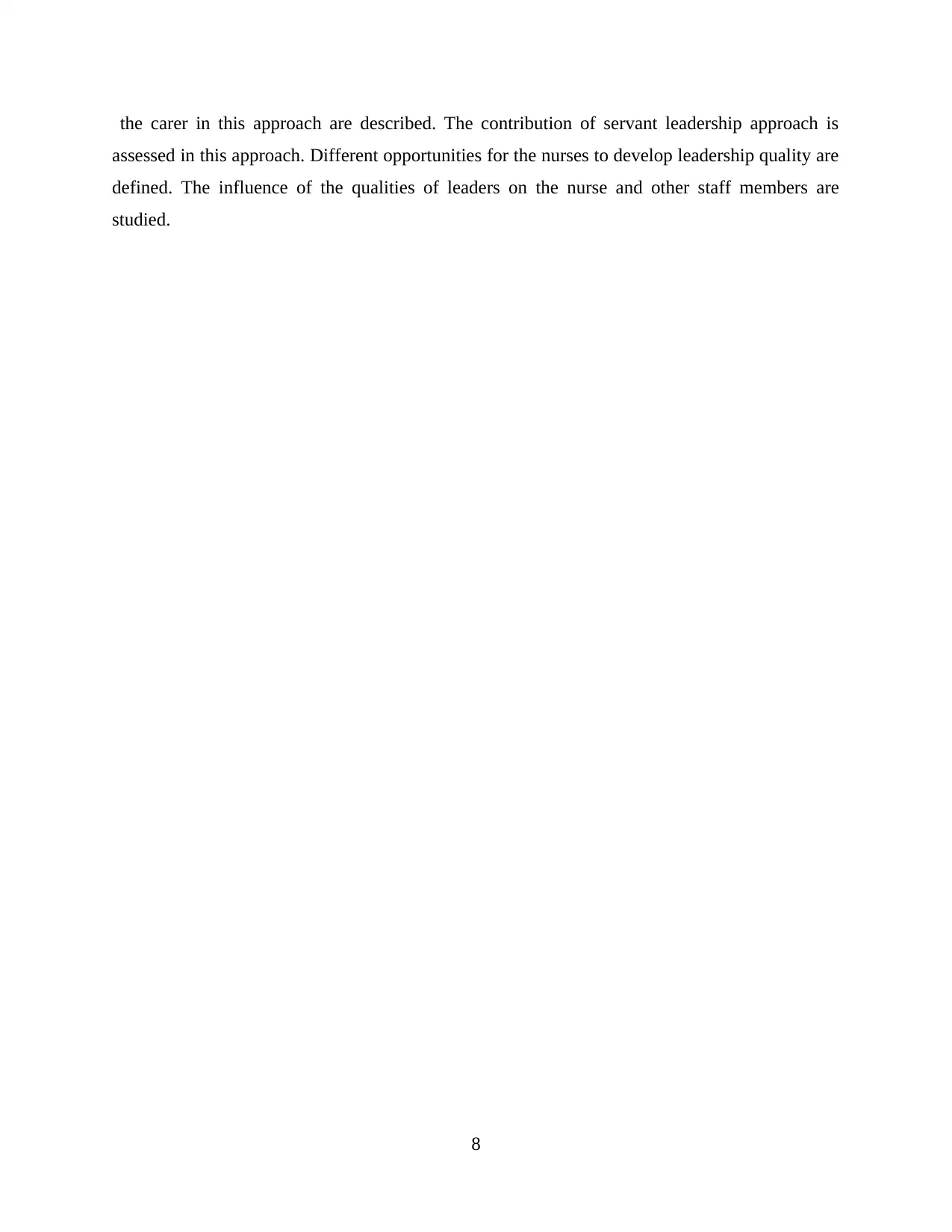
the carer in this approach are described. The contribution of servant leadership approach is
assessed in this approach. Different opportunities for the nurses to develop leadership quality are
defined. The influence of the qualities of leaders on the nurse and other staff members are
studied.
8
assessed in this approach. Different opportunities for the nurses to develop leadership quality are
defined. The influence of the qualities of leaders on the nurse and other staff members are
studied.
8
Paraphrase This Document
Need a fresh take? Get an instant paraphrase of this document with our AI Paraphraser
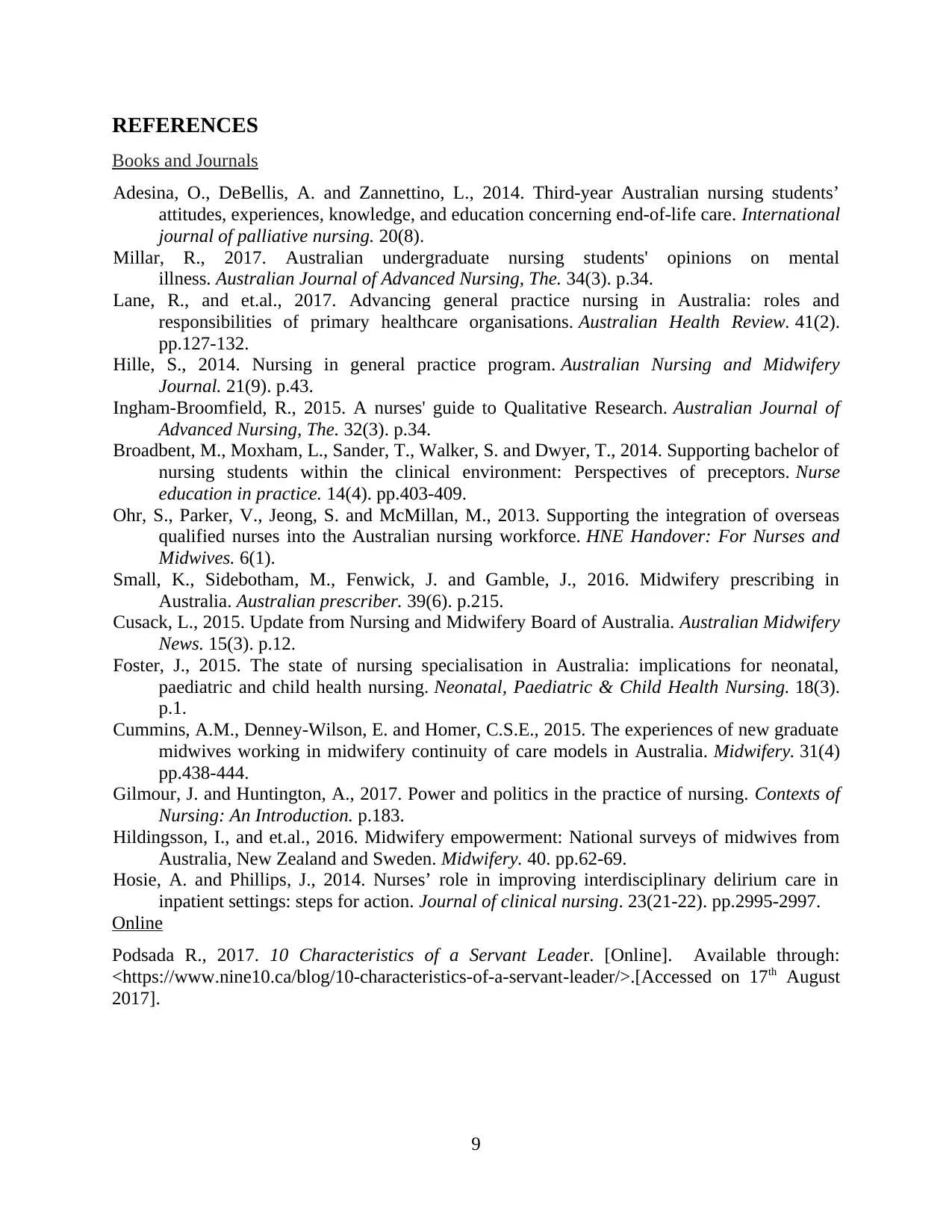
REFERENCES
Books and Journals
Adesina, O., DeBellis, A. and Zannettino, L., 2014. Third-year Australian nursing students’
attitudes, experiences, knowledge, and education concerning end-of-life care. International
journal of palliative nursing. 20(8).
Millar, R., 2017. Australian undergraduate nursing students' opinions on mental
illness. Australian Journal of Advanced Nursing, The. 34(3). p.34.
Lane, R., and et.al., 2017. Advancing general practice nursing in Australia: roles and
responsibilities of primary healthcare organisations. Australian Health Review. 41(2).
pp.127-132.
Hille, S., 2014. Nursing in general practice program. Australian Nursing and Midwifery
Journal. 21(9). p.43.
Ingham-Broomfield, R., 2015. A nurses' guide to Qualitative Research. Australian Journal of
Advanced Nursing, The. 32(3). p.34.
Broadbent, M., Moxham, L., Sander, T., Walker, S. and Dwyer, T., 2014. Supporting bachelor of
nursing students within the clinical environment: Perspectives of preceptors. Nurse
education in practice. 14(4). pp.403-409.
Ohr, S., Parker, V., Jeong, S. and McMillan, M., 2013. Supporting the integration of overseas
qualified nurses into the Australian nursing workforce. HNE Handover: For Nurses and
Midwives. 6(1).
Small, K., Sidebotham, M., Fenwick, J. and Gamble, J., 2016. Midwifery prescribing in
Australia. Australian prescriber. 39(6). p.215.
Cusack, L., 2015. Update from Nursing and Midwifery Board of Australia. Australian Midwifery
News. 15(3). p.12.
Foster, J., 2015. The state of nursing specialisation in Australia: implications for neonatal,
paediatric and child health nursing. Neonatal, Paediatric & Child Health Nursing. 18(3).
p.1.
Cummins, A.M., Denney-Wilson, E. and Homer, C.S.E., 2015. The experiences of new graduate
midwives working in midwifery continuity of care models in Australia. Midwifery. 31(4)
pp.438-444.
Gilmour, J. and Huntington, A., 2017. Power and politics in the practice of nursing. Contexts of
Nursing: An Introduction. p.183.
Hildingsson, I., and et.al., 2016. Midwifery empowerment: National surveys of midwives from
Australia, New Zealand and Sweden. Midwifery. 40. pp.62-69.
Hosie, A. and Phillips, J., 2014. Nurses’ role in improving interdisciplinary delirium care in
inpatient settings: steps for action. Journal of clinical nursing. 23(21-22). pp.2995-2997.
Online
Podsada R., 2017. 10 Characteristics of a Servant Leader. [Online]. Available through:
<https://www.nine10.ca/blog/10-characteristics-of-a-servant-leader/>.[Accessed on 17th August
2017].
9
Books and Journals
Adesina, O., DeBellis, A. and Zannettino, L., 2014. Third-year Australian nursing students’
attitudes, experiences, knowledge, and education concerning end-of-life care. International
journal of palliative nursing. 20(8).
Millar, R., 2017. Australian undergraduate nursing students' opinions on mental
illness. Australian Journal of Advanced Nursing, The. 34(3). p.34.
Lane, R., and et.al., 2017. Advancing general practice nursing in Australia: roles and
responsibilities of primary healthcare organisations. Australian Health Review. 41(2).
pp.127-132.
Hille, S., 2014. Nursing in general practice program. Australian Nursing and Midwifery
Journal. 21(9). p.43.
Ingham-Broomfield, R., 2015. A nurses' guide to Qualitative Research. Australian Journal of
Advanced Nursing, The. 32(3). p.34.
Broadbent, M., Moxham, L., Sander, T., Walker, S. and Dwyer, T., 2014. Supporting bachelor of
nursing students within the clinical environment: Perspectives of preceptors. Nurse
education in practice. 14(4). pp.403-409.
Ohr, S., Parker, V., Jeong, S. and McMillan, M., 2013. Supporting the integration of overseas
qualified nurses into the Australian nursing workforce. HNE Handover: For Nurses and
Midwives. 6(1).
Small, K., Sidebotham, M., Fenwick, J. and Gamble, J., 2016. Midwifery prescribing in
Australia. Australian prescriber. 39(6). p.215.
Cusack, L., 2015. Update from Nursing and Midwifery Board of Australia. Australian Midwifery
News. 15(3). p.12.
Foster, J., 2015. The state of nursing specialisation in Australia: implications for neonatal,
paediatric and child health nursing. Neonatal, Paediatric & Child Health Nursing. 18(3).
p.1.
Cummins, A.M., Denney-Wilson, E. and Homer, C.S.E., 2015. The experiences of new graduate
midwives working in midwifery continuity of care models in Australia. Midwifery. 31(4)
pp.438-444.
Gilmour, J. and Huntington, A., 2017. Power and politics in the practice of nursing. Contexts of
Nursing: An Introduction. p.183.
Hildingsson, I., and et.al., 2016. Midwifery empowerment: National surveys of midwives from
Australia, New Zealand and Sweden. Midwifery. 40. pp.62-69.
Hosie, A. and Phillips, J., 2014. Nurses’ role in improving interdisciplinary delirium care in
inpatient settings: steps for action. Journal of clinical nursing. 23(21-22). pp.2995-2997.
Online
Podsada R., 2017. 10 Characteristics of a Servant Leader. [Online]. Available through:
<https://www.nine10.ca/blog/10-characteristics-of-a-servant-leader/>.[Accessed on 17th August
2017].
9
1 out of 11
Related Documents
Your All-in-One AI-Powered Toolkit for Academic Success.
+13062052269
info@desklib.com
Available 24*7 on WhatsApp / Email
![[object Object]](/_next/static/media/star-bottom.7253800d.svg)
Unlock your academic potential
Copyright © 2020–2025 A2Z Services. All Rights Reserved. Developed and managed by ZUCOL.





